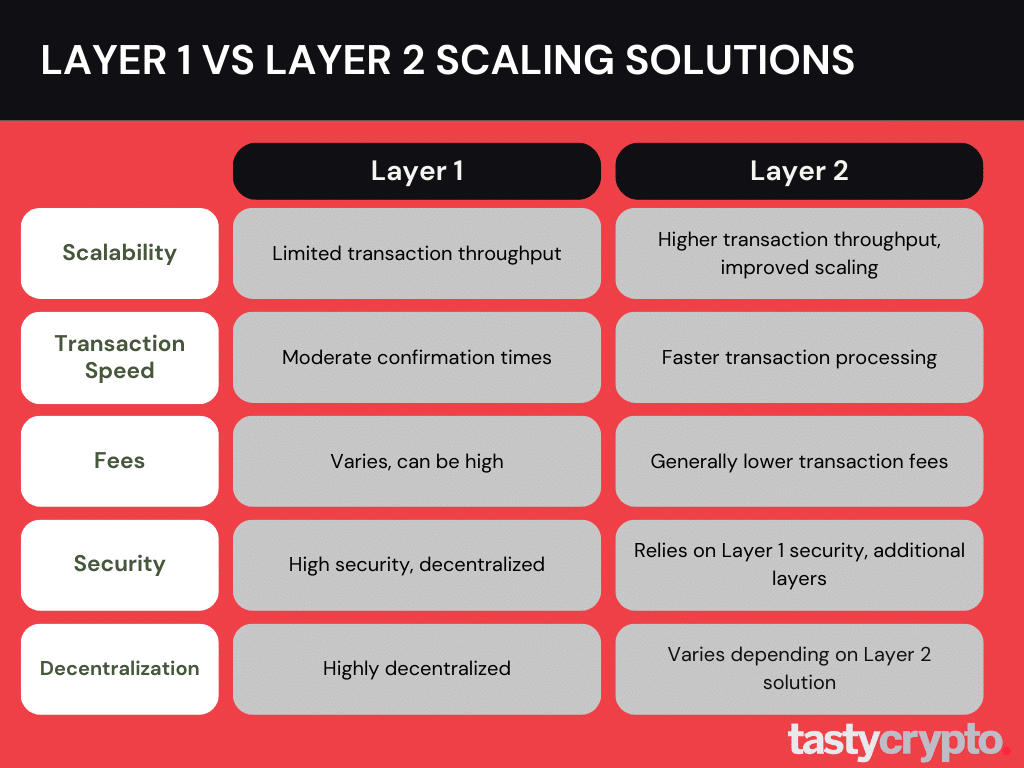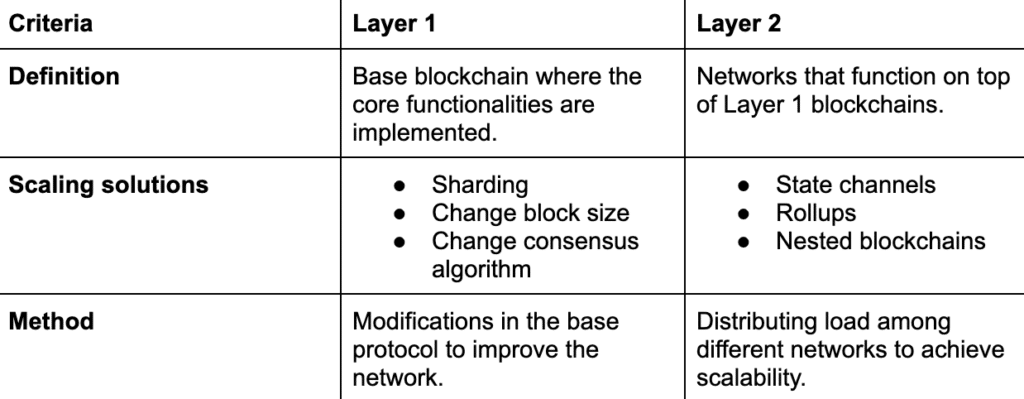Layer 1 blockchains like Ethereum and Bitcoin are the base foundation for layer 2 blockchains to build upon. Layer 2 blockchains allow layer 1 blockchains to scale by offering lower fees and higher transaction throughput.
Written by: Mike Martin | Updated September 5, 2024
Reviewed by: Ryan Grace
Fact checked by: Laurence Willows

Despite the volatility of cryptocurrency, global interest in blockchain and crypto technology is steadily increasing. This growing interest has resulted in added strain on certain blockchains, as their decentralized nature leads to sluggish transaction speeds, low TPS (transactions per second), and higher network and gas fees.
These limitations prevent some networks from effectively scaling. This is where ‘Layer 2 blockchains’ come in. In this article, we will explain the difference between various Layer 1 (main chain) and Layer 2 scaling solutions and show how they influence the blockchain ecosystem.
Table of Contents
🍒 tasty takeaways
-
Increased demand has strained certain blockchains due to slow transaction speeds, low TPS, and high fees.
-
Layer 1 scaling solutions involve changes to the underlying blockchain protocol.
-
Layer 2 scaling solutions distribute transaction processing off-chain while leveraging the security of the underlying blockchain. Layer 2s are popular because of their low transaction fees.
-
Layer 1 solutions prioritize decentralization and security, while Layer 2 solutions focus on scalability and transaction throughput.
Summary
| Aspect | Layer 1 Solutions | Layer 2 Solutions |
|---|---|---|
| Definition | The foundational protocol or base layer of a blockchain network. | Networks or solutions that operate on top of Layer 1 blockchains, conducting transactions and executing contracts off-chain. |
| Objective | Modify the underlying blockchain protocol to achieve scalability, prioritizing decentralization and security. | Alleviate the load on the Layer 1 by processing transactions off-chain, focusing on scalability and transaction throughput. |
| Examples of Solutions | Sharding, Changing Block Size, Changing Consensus Algorithm. | State Channels, Rollups, Nested Blockchains. |
| Benefits | Increased security and decentralization. | Higher transaction throughput and lower transaction fees. |
The Blockchain Scalability Trilemma
In their ideal form, blockchain networks are scalable, decentralized, and secure.
Scalability: a blockchain can handle increasing transaction data and ramp up data processing without sacrificing transaction speed.
Decentralization: no single entity has complete control over the chain. Authority and control are distributed among multiple participants.
Security: the blockchain architecture guarantees secure transactions through the use of cryptographic protocols and consensus mechanisms.
The problem here, however, is that blockchains can only fulfill two of these points.
This is called the scalability trilemma (sometimes also called blockchain trilemma) as described by Ethereum founder Vitalik Buterin.
3 Blockchain Groups
Blockchains can be divided into different groups, all of which have their own advantages and disadvantages.
Traditional blockchains: these chains prioritize decentralization and security by relying on each participant running their own node. Examples are Bitcoin, Ethereum, and Litecoin.
High-TPS chains: blockchains that rely on a small number of nodes with users having to trust these nodes. They thus achieve a high number of transactions and are secure but not decentralized. Examples include BNB Chain, EOS.
Multi-chain ecosystems: various functions are carried out on different blockchains, which communicate with each other using cross-chain protocols. This is decentralized and scalable but at the expense of security.
Overcoming this trade-off is one of the biggest and most important concerns for blockchain technologies, this leads us to the concept of Layer 1 and Layer 2 scaling solutions.
Here is an overview to get us started.

Layer 1 Scaling Solutions
The term ‘Layer 1’ refers to the base Layer or the foundational protocol of a blockchain network. Layer 1 blockchains are the underlying infrastructure that executes all transactions and enables various functions such as the creation and operation of decentralized applications (dApps) and smart contracts. Examples of Layer 1 blockchains are Bitcoin, Ethereum, and Solana.
Layer 1 scaling solutions are also called on-chain scaling. They involve making changes to the base Layer of a blockchain protocol to achieve scalability. Here are a few examples of Layer 1 solutions, each coming with its own benefits and challenges:
Sharding
Sharding divides a blockchain network into smaller partitions called shards. Each shard can process its transactions and smart contracts independently, thereby increasing the overall throughput of the network.
Change Block Size
Blocks are batches of transactions that are confirmed and subsequently recorded on a blockchain. By increasing block size, more transactions can be recorded in a single block, resulting in higher transaction capacity. This is normally done through a hard fork. An example to achieve scalability by increasing block size is Bitcoin Cash. However, larger block size leads to more centralization, because more expensive hardware with higher computing power is needed, which will phase out smaller miners who cannot afford such hardware.
Change Consensus Algorithm
By changing the underlying algorithms, some blockchains aim to increase transaction throughput by optimizing block creation, validation processes, or network communication. Transitioning from Proof of Work (PoW) to Proof of Stake (PoS) is a popular consensus algorithm change. Earlier this year, Ethereum completed its Shanghai upgrade switch to PoS. There are various other consensus algorithms designed to improve scalability, such as Delegated Proof of Stake (DPoS), and Byzantine Fault Tolerance (BFT). Many argue that PoW remains the most secure and decentralized consensus algorithm.
Layer 2 Scaling Solutions
Layer 2 blockchains are networks that work on top of another blockchain. They conduct transactions and execute smart contracts off-chain, reducing the burden on the Layer 1 network while benefiting from its security.
There are different categories of Layer 2 scaling solutions:
1. State Channels
State channels enable the execution of multiple transactions without recording each one on the blockchain. Only the opening and closing balances are recorded, reducing the on-chain load. The Bitcoin Lightning Network and the Raiden Network are examples of off-chain state channels.
2. Rollups
Rollups add multiple transactions into a single transaction or ‘rollup’ that is submitted to the Layer 1 blockchain for final settlement. There are two types of rollups: optimistic rollups (e.g. Optimism, Arbitrum) and zero-knowledge rollups (e.g. zkSync, Polygon). The major difference between the two is that zk-rollup validators must also produce validity proofs to prove that the changes are correct. A detailed article about Arbitrum, Optimis, and Polygon can be found here.
🍒 Arbitrum vs Avalanche vs Optimism: Which is Best in 2023?
3. Nested Blockchains
Nested blockchains are built on top of a main blockchain. They are also called plasma chains. Their architecture involves a parent chain and many child chains. The parent chain specifies the parameters and sends tasks to child chains. Once child chains have finished processing the tasks, the results are sent back to the parent chain. The processing speed is improved significantly because tasks are spread across multiple child chains. An example of a nested blockchain is OMG Plasma. However, some sources categorize plasma chains together with sidechains and validiums as “new chain creation” instead of Layer 2 solutions. However, both new chain creation and Layer 2 scaling belong to off-chain scaling solutions.
Layer 1 vs Layer 2 Overview & Comparison
The following table lists the main differences between Layer 1 and Layer 2 scaling solutions:

Scalability Issues
As described, there are various scalability solutions that developers can use. However, it is also a very complex process. Accordingly, various scalability issues can arise:
Implementing changes or upgrades to the underlying blockchain protocols can be challenging due to the need for coordination and consensus among network participants. At the same time, backward compatibility and smooth transitions during protocol upgrades must be ensured. An example of this is the successful transition from PoW Ethereum to PoS Ethereum.
Flawless interoperability between different networks is essential. However, this is also a major challenge for developers, which can lead to malfunctions. Also, the use of blockchain bridges and other technologies for data exchange between different blockchains creates a gateway for hackers.
FAQs
Generally speaking, Layer 1 scaling solutions (Bitcoin and Ethereum) offer higher security while Layer 2 scaling solutions offer higher transaction throughput and lower fees.
Layer 2 switches provide a limited amount of routing functionalities within network segments like VLANs, while Layer 3 switches enable routing between distinct network segments. Additionally, Layer2s are more cost-efficient than Layer 3s.
Yes, Layer 1’s are generally more secure than Layer 2 scaling solutions.

Siyu Ren Heinrich
5 years of experience in crypto research of writing practical blockchain and crypto analysis on Medium.
MSc in Computer Science, BSc in Smart Engineering, and BSc in Economics and Statistics.
Michael has been active in the crypto community since 2017. He holds certifications from Duke University in decentralized finance (DeFi) and blockchain technology.
🍒 tasty reads


The Core Blockchain and DeFi Ecosystem: What You Need to Know

7 Best DePIN Crypto Projects

What Is Symbiotic and How Does It Work in 2024?

Ethereum vs Ethereum ETFs – 5 Major Differences


